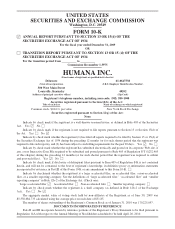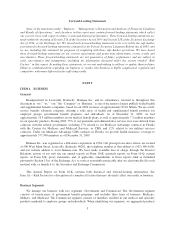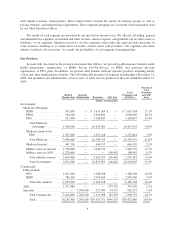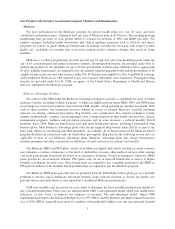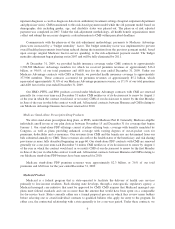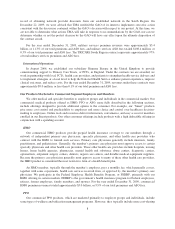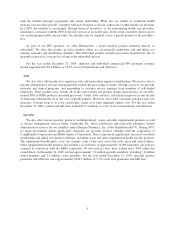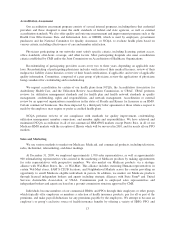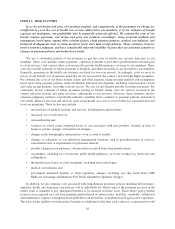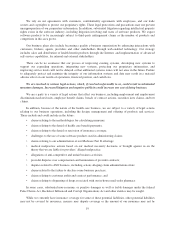Humana 2009 Annual Report Download - page 19
Download and view the complete annual report
Please find page 19 of the 2009 Humana annual report below. You can navigate through the pages in the report by either clicking on the pages listed below, or by using the keyword search tool below to find specific information within the annual report.with the member through copayments and annual deductibles. PPOs also are similar to traditional health
insurance because they provide a member with more freedom to choose a physician or other health care provider.
In a PPO, the member is encouraged, through financial incentives, to use participating health care providers,
which have contracted with the PPO to provide services at favorable rates. In the event a member chooses not to
use a participating health care provider, the member may be required to pay a greater portion of the provider’s
fees.
As part of our PPO products, we offer HumanaOne, a major medical product marketed directly to
individuals. We offer this product in select markets where we can generally underwrite risk and utilize our
existing networks and distribution channels. This individual product includes provisions mandated by law to
guarantee renewal of coverage for as long as the individual chooses.
For the year ended December 31, 2009, employer and individual commercial PPO premium revenues
totaled approximately $3.2 billion, or 10.5% of our total premiums and ASO fees.
ASO
We also offer ASO products to employers who self-insure their employee health plans. We receive fees to
provide administrative services which generally include the processing of claims, offering access to our provider
networks and clinical programs, and responding to customer service inquiries from members of self-funded
employers. These products may include all of the same benefit and product design characteristics of our fully-
insured PPO or HMO products described previously. Under ASO contracts, self-funded employers retain the risk
of financing substantially all of the cost of health benefits. However, most ASO customers purchase stop loss
insurance coverage from us to cover catastrophic claims or to limit aggregate annual costs. For the year ended
December 31, 2009, commercial ASO fees totaled $373.4 million, or 1.2% of our total premiums and ASO fees.
Specialty
We also offer various specialty products, including dental, vision, and other supplemental products as well
as disease management services under Corphealth, Inc. (d/b/a LifeSynch) and mail-order pharmacy benefit
administration services for our members under Humana Pharmacy, Inc. (d/b/a RightSourceRxSM). During 2007,
we made investments which significantly expanded our specialty product offerings with the acquisitions of
CompBenefits Corporation and KMG America Corporation. These acquisitions significantly increased our dental
membership and added new product offerings, including vision and other supplemental health and life products.
The supplemental health plans cover, for example, some of the costs associated with cancer and critical illness.
Other supplemental health products also include a closed block of approximately 36,000 long-term care policies
acquired in connection with the KMG acquisition. No new policies have been written since 2005 under this
closed block. At December 31, 2009, we had approximately 7.2 million specialty members, including 3.8 million
dental members and 2.5 million vision members. For the year ended December 31, 2009, specialty product
premiums and ASO fees were approximately $942.3 million, or 3.1% of our total premiums and ASO fees.
9




